 |
 |
||||||
by
E. S. Valentine
from The Strand Magazine, Vol. 37 (Feb. 1909)
 NEVER had any idea of becoming an artist by profession, not even in my briefless barrister days. Yet I made hundreds of sketches for publication, most of which are, no doubt properly, buried in oblivion. I never drew from models, but odd characters in the London streets attracted me, and I felt an irresistible desire to sketch them for my own amusement or the amusement of my friends."
NEVER had any idea of becoming an artist by profession, not even in my briefless barrister days. Yet I made hundreds of sketches for publication, most of which are, no doubt properly, buried in oblivion. I never drew from models, but odd characters in the London streets attracted me, and I felt an irresistible desire to sketch them for my own amusement or the amusement of my friends."
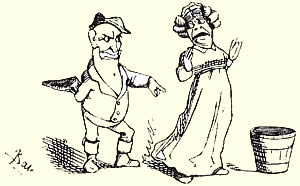 |
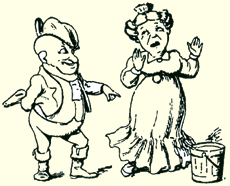 |
| "LOST MR. BLAKE" DRAWN ON WOOD, AT THE AGE OF 30, |
SIR W. S. GILBERT'S VERSION OF THE SAME PICTURE AT THE AGE OF 60, |
Thus did Sr W. S. Gilbert speak in his brusque, downright fashion of his own work as an artist in the pre-"Bab Ballad" days, as we sat together in the sumptuous library at Grims Dyke. As to the illustrations to the "Bab Ballads," the world has long since pronounced its opinion concerning them. In their humour, their quaintness, their individual quality, they are inimitable. It is safe to say that no set of drawings—so slight in technique—ever published have given such universal pleasure. I once saw some of them on a set of china plates made at Canton. They are as immortal as the Ballads themselves. Can one say more in their praise?
How, therefore, I reveled in gazing upon scores of original pen-and-ink sketches done by Gilbert’s own hand, recognising old friends—friends of a lifetime—yet with a difference, a change of expression in the face of the Bishop of Rum-ti-foo, "Lost Mr. Blake," who had lost his severity, and a decided alteration in the costume of the famous crew of the Hot Cross Bun.
But even more interesting to me were a series of sketches of similar character, unknown to fame, which I myself had resurrected years before in the purlieus of Holywell Street—sketches full of the same quality as those of the Ballads, and mush more carefully executed—"carried a little farther," as the technical expression is. I understood that these had been drawn for a book entitled "London Characters," by Henry Mayhew.
"Nothing of the sort," said the author of "Pinafore." "I called them ‘Thumbnail Studies,’ and wrote the letterpress myself. I never illustrated for anybody but myself. Here is what I wrote:-- "‘Who are these people who pass to and fro? What lives are theirs? … Hardly a man passes by who has not some more or less strongly-marked characteristic which may serve to distinguish him from his fellows and give a clue to his previous history. Of course, the clue may be an erroneous one; but if it should prove to be so, that is the fault of the sagacious soul who follows it up too closely’; and so on, giving sketches of company-promoters, artists, officers from Aldershot, theatrical managers, cabmen, comedians, and journalists. This is not the first time I’ve heard of assertions of authorship in things I wrote myself. Only the other day I picked up a volume of autobiography and found the writer laying claim to an article I wrote for the Cornhill forty odd years ago."
 |
| A GAY OLD BACHELOR |
To a student of Gilbert's plays and an appreciation of the humour called Gilbertian it is most diverting to come across these self-same "Thumbnail Studies" the first "lead" in the mine which was to prove so rich in fun-bearing ore. Here are young Gilbert's first paradoxes, his chains of amusing sophistries, his topsy-turvy syllogisms. He draws the picture of a "a wicked old character" whom he sees in St. James's Street, and proceeds to describe him. "He is a gay old bachelor, of disgraceful habits and pursuits—a coarse old villain without a trace of gentlemanly or even manly feelings about him. He stands at his club window by day. At dinner he drinks himself into a condition of drivelling imbecility, from which he only arouses himself in time to stagger round to the nearest stage-door. His income is probably derived from the contributions of disgusted connections who pay to keep him out of their sight."
But, of course, this reading of character may be all wrong. "As a rule it is better to think, but not think too deeply. If we don't think at all our mind is but a blank; if we just glance below the surface we may, without difficulty, conjure up a host of pleasant paradoxes, the contemplation of which is enough to keep the mind amused and give play to a healthy and fanciful reflection. But if we think too deeply we come to the reason of things—we destroy our visionary castles, we brush away our quaint theories, and we reduce everything to the absolute dead-level from which we started."
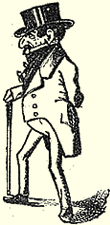 |
 |
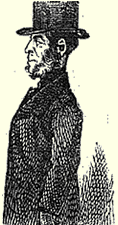 |
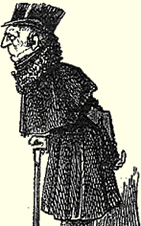 |
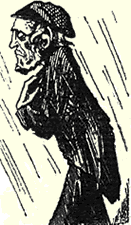 |
| A BILL-DISCOUNTER | AN ARTISTIC CHARLATAN | A DETECTIVE | A CURIOUS OLD BACHELOR | A MISERABLE GHOST |
When Gilbert drew the first illustration above he made up his mind that he was representing a thriving bill-discounter. "He is an old gentleman who has, at various epochs in his career, been a wine-merchant, a cigar-dealer, a Boulogne billiard-player, a trafficker in Army commissions, a picture-dealer, a horse-dealer, a theatrical manager, and a bill-discounter."
If you want to know what certain artists could look like in mid-Victorian times, direct your glance to the above Gilbertian sketch of "an artistic charlatan." We are told that his get-up is astoundingly professional, and his talk is studio slang. He never paints anything, but haunts studios and bothers hard-working craftsmen by the hour together. He has been all over the world, and knows every picture in every gallery in Europe. To hear him talk you would think that he was the acknowledged head of his profession. Certainly, as far as his exterior goes, there never was so artistic an artist (out of comedy) as he."
Gilbert presents us with a whole gallery of characters, in many of whom we may detect both the germ and the prototype of the personnel of his operas. Of the next sketch we are told that "he is awake to most things, and his only delusion is that, being a policeman in plain clothes, he looks like a prosperous shopkeeper, a confidential clerk, a nobleman of easy manners, or a country yokel in town for a 'spree,' according to the characters which the peculiarities of his several cases require him to assume. The more he disguises himself," the author adds, "the more he looks the policeman in plain clothes". The type is a familiar one today.
A type not so familiar is that of the "curious old bachelor of eccentric habits" to whom the famous playwright next introduces us. "Nobody knows much about him except a confidential manservant, who effectually defeats any attempt to pump him on the subject of his master's eccentricities. All that is known of him is that he lives in a lodging-house in Duke Street, St. James's. He has a horror of children and tobacco and a nervous dread of hansom cabs; he takes a walk between two and three every afternoon up St. James's Street, stopping regularly at Sam's to look at the profile pictures of distinguished sporting and other noblemen, and finishing up with a Bath bun and a glass of cherry brandy at the corner of Bond Street. He is supposed by some to be a fraudulent banker, by others a disgraced clergyman, by others an escaped convict of desperate character, and by the more rational portion of his observers as a harmless monomaniac... There is a rumour afloat that he is a Royal descendant of Hannah Lightfoot, and that he is only waiting for an opportunity to declare his rights and step at once into the throne of England".
A different note is struck here: "One of those miserable ghosts that start up from time to time in the London streets, to sicken the rich man of his wealth and to disgust the happy man with his happiness... He is, of course, a thief; who, in his situation, would not be? He is a liar; but his lies are told for bread. He is a blasphemer; God help him, what has he to be thankful for?
 |
|||
| A PROMOTER OF PUBLIC COMPANIES | A PLAYWRIGHT | FOURTH-RATE FAMILY DOCTOR | AN ANTICIPATION OF MR. BIRRELL |
Next is "a gentleman about whom there can be no mistake. He is a promoter of public companies... He is a specious, showy, flashily-dressed, knowing-looking gentleman, with a general knowledge of most things and an especial and particular acquaintance with the manners and customs of fools in general.
Gilbert's sketch of a theatrical manager might almost serve as a portrait of the artist himself in his later years, although the possibility of this would probably have surprised him when he made the drawing nearly a half-century ago. Speaking of such likenessess, might not the sketch above serve as a caricature of Mr. Birrell, minus his spectacles?
In the same set is also given a specimen of "that bland, gentlemanly, useful humbug, the fourth-rate family doctor. Although undoubtedly a humbug, he is not a quack. He has satisfied the College of Surgeons and has passed the Hall with decency; he has even, perhaps, graduated as M.B. at London, and is consequently styled 'doctor' by courtesy. But he is a humbug for all that."
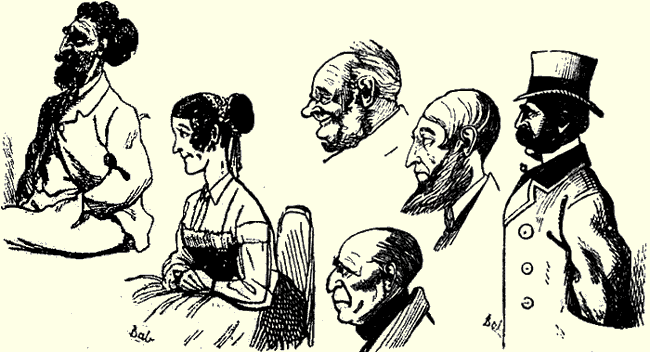 |
|||
| A THEATRICAL CRITIC |
LADY IN THE DRESS CIRCLE | SOME PITTITRS | A THEATRICAL MANAGER |
 |
| A FOUR-WHEEL CABMAN, 1865 |
Then follow two or three drawings by Sir William, made in the theatre as a young man, one a theatrical critic, another a lady representative "of that extensive element in most dress-circles which finds its way into theatres by means of free admissions. It is a curious feature in theatrical management—and a feature that doesn't seem to exist in any other form of commercial enterprise—that, if you can't get people to pay for admission, you must admit them for nothing. Nobody ever heard of a butcher scattering steaks broadcast among the multitude because his customers fall off; neither is there any instance on record of a banker volunteering to oblige penniless strangers with an agreeable balance. Railway companies do not send free passes for general distribution to eel-pie shops, nor does a baker place his friends on the free list."
If the characters in the front row of the pit have changed in these days, it is not so with the four-wheel cabman depicted here. He might be drawn from life, Anno Domini 1909, in many a Metropolitan quarter.
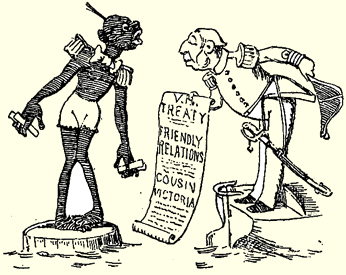 |
| "I come, if you please, with the best intents And Queen Victoria's compliments." THE LATE LORD GOSCHEN AS A NAVAL REPRESENTATIVE |
In the case of the "Bab Ballads" drawings Sir William told me that he made a preliminary sketch in pencil, the outlines of which he afterwards transferred to a small wood block. Here he continued the sketch, always in pencil. As time wore on and the block wore out he set about making a new set of drawings. These he executed in ink on Bristol board, working on the same minute scale as if he had been drawing on the block. He by no means adhered to his original conception always, as was to be seen in the case of several drawings. In some I preferred the first idea as well as the first execution. But in other instances the second drawing was the better or the funnier.
The late Lord Goschen, who was a great admirer of the "Bab Ballads," was much astonished to find himself figuring in one of them—an amended one—as Queen Victoria's naval representative. This was at a time when he had not yet decided to accept the post of First Lord of the Admiralty. The waggish picture perhaps influenced his decision, but his only comment was, "Now I know why Gilbert looked at me so hard at the Academy dinner the other evening!"
In the same way, Robert Louis Stephenson can hardly have failed to recognise his own lineaments in the gentleman who figures as "The Disconcerted Tenor." But Gilbert often has amused himself in this way. In one of his drawings Miss Fortescue appears seated at a piano, while as for his caricature of the late Sir Eyre Massey Shaw, as a fireman with the hose in his grasp, it has been pronounced a "wicked likeness."
 |
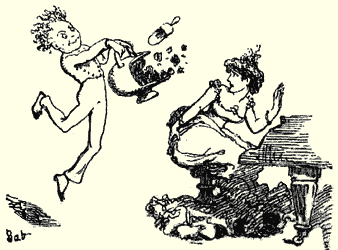 |
|
| ROBERT L. STEVENSON AS "THE DISCONCERTED TENOR" |
He skipped for joy like little muttons; he danced like Esmerelda's kid. A DELINEATION OF MISS FORTESCUE |
|
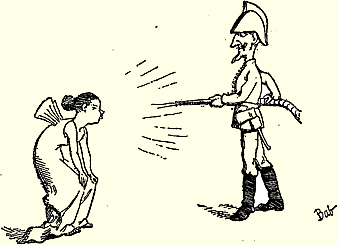 |
||
| SIR EYRE MASSEY SHAW AS A FIREMAN | ||
In some of his designs the influence of Sir John Tenniel is manifest, and this without their ceasing to be characteristically Gilbertian. In glancing at some, one would say that Punch lost a great cartoonist when it first discouraged Sir, W. S. Gilbert. What a fund of observation is denoted in the picture of the two braw Scotsmen listening to Clonglocketty Angus M'Clan Corby Torbay attempting to discourse the sweet strains of "In My Cottage":—
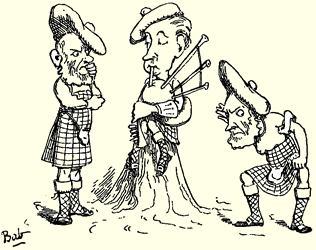 |
| TWO BRAW SCOTSMEN |
For a year, seven months, and a fortnight, until
(You'll hardly believe it) M'Clan, I declare,
Elicited something resembling an air.
There is quite the professional cartoonist touch in the gentleman in Roman garb sipping his Falernian reproduced from the original drawing herewith.
 |
| "They wore little underclothing—scarcely anything or nothing, And their dress of Coan silk was quite transparent in design." |
Page modified 7 April 2018